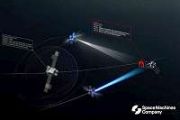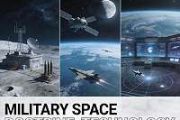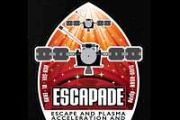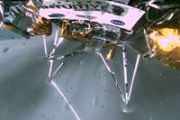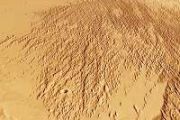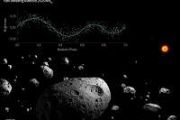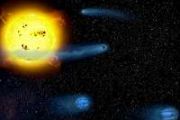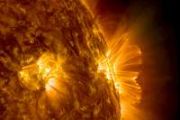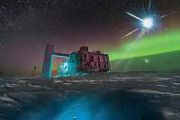
Copernical Team
Cool comfort: beating the heat with high-tech clothes
 As global temperatures rise and heatwaves intensify, a new textile innovation co-developed by University of South Australia scientists promises to keep people cooler, drier, and more comfortable in extreme heat.
Partnering with researchers from Zhengzhou University in China, UniSA materials scientist Professor Jun Ma has helped to create a lightweight breathable fabric that reflects 96% of
As global temperatures rise and heatwaves intensify, a new textile innovation co-developed by University of South Australia scientists promises to keep people cooler, drier, and more comfortable in extreme heat.
Partnering with researchers from Zhengzhou University in China, UniSA materials scientist Professor Jun Ma has helped to create a lightweight breathable fabric that reflects 96% of Calcite deposit from southern Nevada cave reveals 580,000 years of climate history
 Climate history recorded in a calcite deposit in a southern Nevada cave indicates that the hot, arid southwestern United States experienced significant shifts in temperature and rainfall over the last 580,000 years.
The findings, just published in the journal Nature Communications, provide new insight into the region's hydroclimate and how it may evolve in the future, said Kathleen Wendt,
Climate history recorded in a calcite deposit in a southern Nevada cave indicates that the hot, arid southwestern United States experienced significant shifts in temperature and rainfall over the last 580,000 years.
The findings, just published in the journal Nature Communications, provide new insight into the region's hydroclimate and how it may evolve in the future, said Kathleen Wendt, Drilling deep to study the oxygenation of Earth
 Some 2.3 to 2.4 billion years ago, Earth underwent a monumental transformation that forever altered the planet's course. Cyanobacteria evolved a new kind of photosynthesis that unleashed tremendous amounts of oxygen into the oceans and atmosphere, setting the stage for life as we know it.
The oxygenation of the planet, known as the "Great Oxygenation Event" or GOE, was undeniably monumenta
Some 2.3 to 2.4 billion years ago, Earth underwent a monumental transformation that forever altered the planet's course. Cyanobacteria evolved a new kind of photosynthesis that unleashed tremendous amounts of oxygen into the oceans and atmosphere, setting the stage for life as we know it.
The oxygenation of the planet, known as the "Great Oxygenation Event" or GOE, was undeniably monumenta Scientists track recent solar flare disruptions in Earth's ionosphere
Verifying that you are not a bot
Plasmasphere compressed by recent geomagnetic superstorm dramatically slowed recovery
 Researchers have detailed how a geomagnetic superstorm on May 10-11, 2024, shrank Earth's plasmasphere, a protective zone of charged particles, to just one-fifth of its normal size. The event, named the Gannon storm or Mother's Day storm, was the most powerful in over twenty years.
Led by Dr. Atsuki Shinbori at Nagoya University's Institute for Space-Earth Environmental Research, the team
Researchers have detailed how a geomagnetic superstorm on May 10-11, 2024, shrank Earth's plasmasphere, a protective zone of charged particles, to just one-fifth of its normal size. The event, named the Gannon storm or Mother's Day storm, was the most powerful in over twenty years.
Led by Dr. Atsuki Shinbori at Nagoya University's Institute for Space-Earth Environmental Research, the team Moss spores withstand long term exposure outside space station
 Researchers have demonstrated that moss sporophytes can withstand nine months of direct exposure to outer space and remain reproductively viable upon return to Earth. The study, published November 20 in the journal iScience, tested the durability of Physcomitrium patens spores affixed to the outside of the International Space Station.
Lead author Tomomichi Fujita of Hokkaido University exp
Researchers have demonstrated that moss sporophytes can withstand nine months of direct exposure to outer space and remain reproductively viable upon return to Earth. The study, published November 20 in the journal iScience, tested the durability of Physcomitrium patens spores affixed to the outside of the International Space Station.
Lead author Tomomichi Fujita of Hokkaido University exp Lunar dust model highlights risks for spacecraft and future moon base projects
 A group of researchers in China has developed a new theoretical model to study how low-velocity lunar dust interacts with spacecraft surfaces. The model is designed to improve predictions about dust adhesion and removal, supporting long-term lunar missions and base construction.
The study explains that the lunar surface is covered in fine dust which has a strong tendency to stick to spacec
A group of researchers in China has developed a new theoretical model to study how low-velocity lunar dust interacts with spacecraft surfaces. The model is designed to improve predictions about dust adhesion and removal, supporting long-term lunar missions and base construction.
The study explains that the lunar surface is covered in fine dust which has a strong tendency to stick to spacec Destination: Mars. First Stop: Iceland?
 To say that a trip from Earth to Mars is merely a long one would be a massive understatement. On July 30, 2020, when the National Aeronautics and Space Administration (NASA) sent its Mars rover "Perseverance" atop an Atlas V rocket to the red planet to collect rock samples, it took the rover nearly seven months to reach its destination. This was only one step in a complex process that will take
To say that a trip from Earth to Mars is merely a long one would be a massive understatement. On July 30, 2020, when the National Aeronautics and Space Administration (NASA) sent its Mars rover "Perseverance" atop an Atlas V rocket to the red planet to collect rock samples, it took the rover nearly seven months to reach its destination. This was only one step in a complex process that will take Lunar impactor Theia originated near Earth and Sun analysis reveals
 A new study published in Science has traced the origin of Theia, the body that collided with Earth around 4.5 billion years ago and triggered the creation of the Moon. Led by the Max Planck Institute for Solar System Research and University of Chicago, the research utilizes ratios of metal isotopes to uncover Theia's place of origin and composition.
The collision with Theia dramatically al
A new study published in Science has traced the origin of Theia, the body that collided with Earth around 4.5 billion years ago and triggered the creation of the Moon. Led by the Max Planck Institute for Solar System Research and University of Chicago, the research utilizes ratios of metal isotopes to uncover Theia's place of origin and composition.
The collision with Theia dramatically al NASA celebrates a decade of student contributions to space crop production
 In 2025, nearly 1,250 students in 71 classrooms participated in the Growing Beyond Earth Student Launch Chat, celebrating ten years of partnership between Fairchild Tropical Botanic Garden and NASA. Students presented data from classroom crop experiments to NASA Kennedy Space Center experts, supporting NASA's work on selecting crops for future Moon and Mars missions.
Growing Beyond Earth i
In 2025, nearly 1,250 students in 71 classrooms participated in the Growing Beyond Earth Student Launch Chat, celebrating ten years of partnership between Fairchild Tropical Botanic Garden and NASA. Students presented data from classroom crop experiments to NASA Kennedy Space Center experts, supporting NASA's work on selecting crops for future Moon and Mars missions.
Growing Beyond Earth i 

